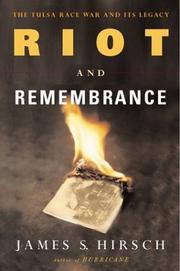Check nearby libraries
Buy this book

"On a warm night in May 1921, thousands of whites, many deputized by the local police, swarmed through the Greenwood section of Tulsa, Oklahoma, killing scores of blacks, looting, and ultimately burning the neighborhood to the ground. In the aftermath, as many as 300 were dead, and 6,000 Greenwood residents were herded into detention camps.".
"James Hirsch focuses on the de facto apartheid that brought about the Greenwood riot and informed its eight-year legacy, offering an unprecedented examination of how a calamity spawns bigotry and courage and how it has propelled one community's belated search for justice. Tulsa's establishment and many victims strove to forget the events of 1921, destroying records pertaining to the riot and refusing even to talk about it. This cover-up was carried through the ensuing half-century with surprising success.
Even so, the riot wounded Tulsa profoundly, as Hirsch demonstrates in a combination of history, journalism, and character study. White Tulsa thrived, and the city became a stronghold of Klan activity as workingmen and high civic officials alike flocked to the Hooded Order. Meanwhile, Greenwood struggled as residents strove to rebuild their neighborhood despite official attempts to thwart them. As the decades passed, the economic and social divides between white and black worlds deepened. Through the 1960s and 1970s, urban renewal helped to finish what the riot had started, blighting Greenwood.
Paradoxically, however, the events of 1921 saved Tulsa from the racial strife that befell so many other American cities in the 1960s, as Tulsans white and black would do almost anything to avoid a reprise of the riot."--BOOK JACKET.
Check nearby libraries
Buy this book

Previews available in: English
Showing 5 featured editions. View all 5 editions?
| Edition | Availability |
|---|---|
|
1
Riot and Remembrance: The Tulsa Race War and Its Legacy
2014, Houghton Mifflin Harcourt Trade & Reference Publishers
in English
0544374185 9780544374188
|
zzzz
Libraries near you:
WorldCat
|
| 2 |
zzzz
|
|
3
Riot and Remembrance: America's Worst Race Riot and Its Legacy
June 6, 2003, Mariner Books
in English
0618340769 9780618340767
|
zzzz
Libraries near you:
WorldCat
|
|
4
Riot and remembrance: the Tulsa race war and its legacy
2002, Houghton Mifflin
in English
0618108130 9780618108138
|
aaaa
Libraries near you:
WorldCat
|
|
5
Riot and Remembrance: The Tulsa Race War and Its Legacy
2001, Houghton Mifflin Harcourt Trade & Reference Publishers
in English
0618392513 9780618392513
|
zzzz
Libraries near you:
WorldCat
|
Book Details
Edition Notes
Includes bibliographical references (p. [333]-339) and index.
Classifications
The Physical Object
ID Numbers
Source records
Scriblio MARC recordLibrary of Congress MARC record
Library of Congress MARC record
Internet Archive item record
marc_openlibraries_sanfranciscopubliclibrary MARC record
Marygrove College MARC record
Library of Congress MARC record
Better World Books record
marc_columbia MARC record
Work Description
A best-selling author investigates the causes of the twentieth century's deadliest race riot and how its legacy has scarred and shaped a community over the past eight decades. On a warm night in May 1921, thousands of whites, many deputized by the local police, swarmed through the Greenwood section of Tulsa, Oklahoma, killing scores of blacks, looting, and ultimately burning the neighborhood to the ground. In the aftermath, as many as 300 were dead, and 6,000 Greenwood residents were herded into detention camps. James Hirsch focuses on the de facto apartheid that brought about the Greenwood riot and informed its eighty-year legacy, offering an unprecedented examination of how a calamity spawns bigotry and courage and how it has propelled one community's belated search for justice. Tulsa's establishment and many victims strove to forget the events of 1921, destroying records pertaining to the riot and refusing even to talk about it. This cover-up was carried through the ensuing half-century with surprising success. Even so, the riot wounded Tulsa profoundly, as Hirsch demonstrates in a compelling combination of history, journalism, and character study. White Tulsa thrived, and the city became a stronghold of Klan activity as workingmen and high civic officials alike flocked to the Hooded Order. Meanwhile, Greenwood struggled as residents strove to rebuild their neighborhood despite official attempts to thwart them. As the decades passed, the economic and social divides between white and black worlds deepened. Through the 1960s and 1970s, urban renewal helped to finish what the riot had started, blighting Greenwood. Paradoxically, however, the events of 1921 saved Tulsa from the racial strife that befell so many other American cities in the 1960s, as Tulsans white and black would do almost anything to avoid a reprise of the riot. Hirsch brings the riot's legacy up to the present day, tracing how the memory of the massacre gradually revived as academics and ordinary citizens of all colors worked tirelessly to uncover evidence of its horrors. Hirsch also highlights Tulsa's emergence at the forefront of the burgeoning debate over reparations. RIOT AND REMEMBRANCE shows vividly, chillingly, how the culture of Jim Crow caused not only the grisly incidents of 1921 but also those of Rosewood, Selma, and Watts, as well as less widely known atrocities. It also addresses the cruel irony that underlies today's battles over affirmative action and reparations: that justice and reconciliation are often incompatible goals. Finally, Hirsch details how Tulsa may be overcoming its horrific legacy, as factions long sundered at last draw together.
Links outside Open Library
Community Reviews (0)
Feedback?| August 6, 2021 | Edited by New York Times Bestsellers Bot | Add NYT review links |
| August 14, 2020 | Edited by ImportBot | import existing book |
| December 13, 2019 | Edited by MARC Bot | import existing book |
| July 22, 2019 | Edited by MARC Bot | remove fake subjects |
| December 10, 2009 | Created by WorkBot | add works page |











